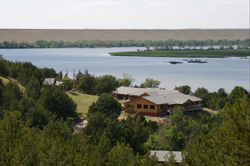 |
The Cedar Point Biological Station near Lake McConaughy. |
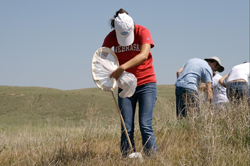 |
Students collect grasshoppers on the Arapaho prairie to measure the prevalence of a parasitic mite. |
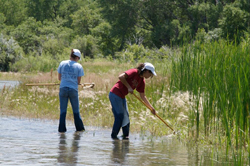 |
Students use dip nets to collect predatory beetle larvae and their prey. |
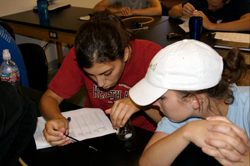 |
Students created survival curves by tracking the number of captured midges still alive at the beginning of several consecutive days. |
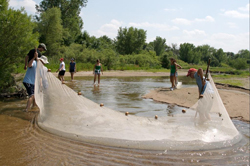 |
Students seine for minnows in the South Platte River. |
He spent his summers wandering the wet meadows, creeks, prairies and sandhill grassland with his father, Brent Nickol, Ph.D., a parasitologist at the University of Nebraska-Lincoln and former director of the biological field station.
“The time I spent there made me want to go into biology and medicine,” Dr. Nickol said.
This past summer, the “faculty kid” returned to Cedar Point — which is on the south shore of Lake Ogallala about eight miles northeast of Ogallala, Neb. — to teach the first ever field epidemiology course intended for fourth-year UNMC medical students and upper level UNL undergraduates. Fourth-year medical students can take the course as a regular senior elective or as a basic science selective.
The three-week course emphasizes the importance of basic science and evidence-based medicine, an area that has become increasingly important in medicine, said Dr. Nickol, an assistant professor in UNMC’s Internal Medicine Department and 1996 College of Medicine graduate.
“As a field, evidence-based medicine is relatively new, and it’s an area that is hard to teach and hard to learn.”
In fact, Dr. Nickol was unable to find course models to replicate so he created his own field curriculum.
“It was a challenge because I’m not a parasitologist or invertebrate zoologist or epidemiologist,” Dr. Nickol said. “I had to learn quite a few basic principles while designing the field exercises. Fortunately, I had my father and other biology faculty to help, and a great graduate student as a teaching assistant.
“Evidence-based medicine is often taught in lecture and small groups, but it’s difficult to reproduce the real world aspects of evidence-based medicine in the classroom,” Dr. Nickol said. “That was the driving force for building the field course.”
|
“We did experiments to put theoretical concepts into a real world context,” Dr. Nickol said. “We were in the field daily. To learn about cohort studies we did one. To learn about statistical techniques, we would apply them to actual populations rather than just read about them.”
Students then analyzed the field problems and presented the results in both oral and written formats.
With one exercise, students collected grasshoppers to determine the prevalence of a bright, red thoracic mite in various populations.
To look at measures of mortality in a disease, students collected a predatory species of beetle larva and amphipods and observed them in Petri dishes. Using toads, students assessed disease burden using both screening and gold standard testing methods.
Although this year’s inaugural class started with only eight students, Dr. Nickol anticipates all 20 slots being filled next summer as more students become aware of the course. No UNMC students participated this summer, however, Dr. Nickol has a fall grand rounds planned to spark interest.
“It’s not right for every student, but it’s ideally suited for those with an interest in academic medicine or research,” he said. “We climbed barbed wire fences and got muddy and wet tramping across fields and through streams. It’s not a course for someone who wants to sit in an air-conditioned classroom all day, but the students had a good time and the more time we spent in the field the happier they were.”
For more information on the Cedar Point Biological Station, which is operated by UNL’s School of Biological Sciences, visit cedarpoint.unl.edu.